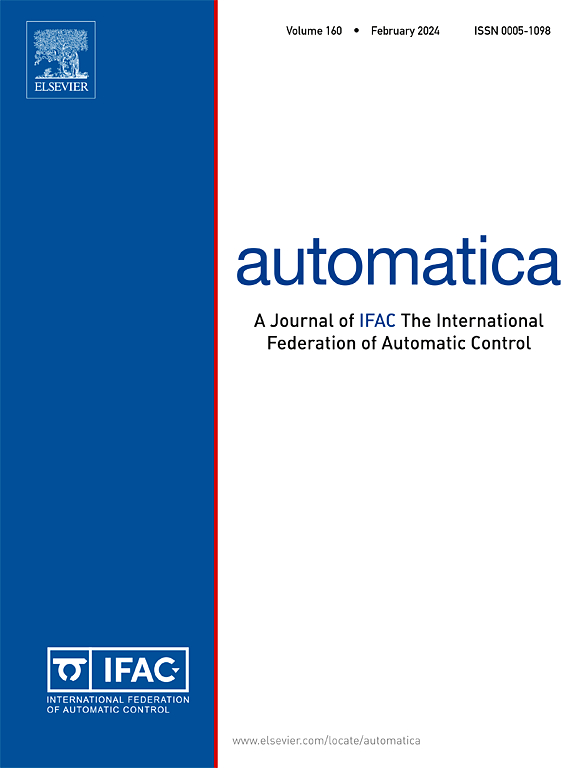Accuracy bounds for the simulation of a class of continuous-time nonlinear models
IF 5.9
2区 计算机科学
Q1 AUTOMATION & CONTROL SYSTEMS
引用次数: 0
Abstract
Real-world dynamic systems evolve in the continuous-time world, while their models are simulated in the digital world using discrete-time numerical simulation algorithms. Such simulation is essential for a variety of system and control problems such as system identification and performance analysis of (control) systems. Ideally, the simulated model response should be identical to the system response. However, this is typically not the case in practice, even when the effects of unmodelled dynamics and parametric uncertainty are excluded. Even in that scenario, a mismatch exists between the response of the system and the model due to the interface between the physical world and the digital computer, unknown disturbances, and simulation inaccuracies. For the class of continuous-time, nonlinear Lur’e-type systems, this paper analyses the mismatch between the steady-state system response and the steady-state model response computed using the so-called mixed time–frequency algorithm. Firstly, a bound on the mismatch between the steady-state system response and the computed steady-state model response based on continuous-time signals is derived. Secondly, a bound for the same mismatch is derived for a sampled version of the signals. The bounds are further decomposed into several components, each given an interpretation that can be used to reduce the bounds on the mismatch. In a numerical case study, we show that reducing the bounds also reduces the actual mismatch.
一类连续时间非线性模型仿真的精度界
现实世界的动态系统在连续时间世界中演化,而它们的模型在数字世界中使用离散时间数值模拟算法进行模拟。这种仿真对于各种系统和控制问题,如系统识别和(控制)系统的性能分析是必不可少的。理想情况下,模拟的模型响应应该与系统响应相同。然而,即使排除了未建模的动力学和参数不确定性的影响,实际情况通常也不是这样。即使在这种情况下,由于物理世界和数字计算机之间的接口、未知的干扰和模拟的不准确性,系统的响应和模型之间也存在不匹配。对于一类连续时间非线性Lur ' e型系统,本文分析了用混合时频算法计算的稳态系统响应与稳态模型响应之间的不匹配问题。首先,推导了基于连续时间信号的稳态系统响应与计算得到的稳态模型响应不匹配的边界;其次,对信号的采样版本导出相同失配的边界。边界进一步分解为几个组件,每个组件都给出一个解释,可用于减少不匹配的边界。在一个数值案例研究中,我们表明减少边界也减少了实际的不匹配。
本文章由计算机程序翻译,如有差异,请以英文原文为准。
求助全文
约1分钟内获得全文
求助全文
来源期刊

Automatica
工程技术-工程:电子与电气
CiteScore
10.70
自引率
7.80%
发文量
617
审稿时长
5 months
期刊介绍:
Automatica is a leading archival publication in the field of systems and control. The field encompasses today a broad set of areas and topics, and is thriving not only within itself but also in terms of its impact on other fields, such as communications, computers, biology, energy and economics. Since its inception in 1963, Automatica has kept abreast with the evolution of the field over the years, and has emerged as a leading publication driving the trends in the field.
After being founded in 1963, Automatica became a journal of the International Federation of Automatic Control (IFAC) in 1969. It features a characteristic blend of theoretical and applied papers of archival, lasting value, reporting cutting edge research results by authors across the globe. It features articles in distinct categories, including regular, brief and survey papers, technical communiqués, correspondence items, as well as reviews on published books of interest to the readership. It occasionally publishes special issues on emerging new topics or established mature topics of interest to a broad audience.
Automatica solicits original high-quality contributions in all the categories listed above, and in all areas of systems and control interpreted in a broad sense and evolving constantly. They may be submitted directly to a subject editor or to the Editor-in-Chief if not sure about the subject area. Editorial procedures in place assure careful, fair, and prompt handling of all submitted articles. Accepted papers appear in the journal in the shortest time feasible given production time constraints.
 求助内容:
求助内容: 应助结果提醒方式:
应助结果提醒方式:


